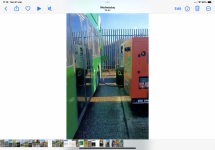20 odd years ago I wanted to tow a vehicle behind my 28 foot Gulfstream to use for local sightseeing where the Motorhome will not go and in 85,000 miles around Europe we have been in some very tight places.
In a "normal" trailer the coupling contracts to apply the trailer brakes using the force between the trailer and the towing vehicle.
There is a major defect in this system.
1 the difference in deceleration is integrated to a difference in velocity.
2 the difference in velocity is integrated into a difference in position which is used to apply the brakes.
3 Anyone who studied control theory knows that two integrators in a feedback loop will oscillate just as the old Rice trailers did. The "normal" solution is to apply a hydraulic damper (shock absorber) to quell the oscillations.
4. Apart from the initial shove from behind that lasts for nearly the maximum of 0.6 secs, the solution is only viable with a fixed trailer mass. It is very load dependant.
5 The "normal" system releases the brakes at 8% when reversing so the you do not need to get out to engage the old reversing lock because that could be left on and that is dangerous. However a fully loaded trailer when parked on an incline released its brakes at 8% and careered down hill killing two people
I don’t accept there is a “major defect” in overrun braking systems unless you go back to pre Oct ‘82, when spring actuated couplings were outlawed on new trailers. That’s over 40 years ago!
Back in the day, we referred to them as ‘Surge Brakes’. They did indeed oscillate as there was no damping effect. If you braked the towing vehicle, once the trailer was travelling faster than it, the trailer thumped you in the back, then the trailer brake almost immediately released. This continued to repeat until the trailer speed was reduced to a point that didn’t exceed the towing vehicle’s, or, until the combined mass and velocity of the trailer was insufficient to overcome the resistance of the spring.
Surge brakes were highly inefficient and grossly uncomfortable!
EC71/320 (and later legislation) changed everything. By Oct ‘82, all new (cat O2) trailer builds had to incorporate hydraulic or gas strut damping. By April ‘89, they also had to include an auto-reverse facility. This required energy stores on the handbrake of the coupling
and an additional to the trailer’s brake mechanisms which released the brakes if the wheels were operating in a reverse direction. The maximum allowable drag while reversing was 8%.
It’s this that makes inertia (overrun) braking systems unsuitable for ‘towed cars’ as no car includes the necessary alteration to the brake mechanisms.
With a properly adjusted set-up, even a fully loaded trailer cannot runaway after the handbrake has been applied as the energy store is progressive. Even in reverse (where the brakes could theoretically release), the energy store will continue to take up any slack in the system and maintain the status quo.
The coupling’s handbrake itself is actuated (in the event of disconnection from the towball) by a, relatively lightweight, breakaway cable.
https://spinner28.wixsite.com/tonys-towing-trivia/post/the-importance-of-breakaway-cables
Type approval and certification of trailers (with associated VIN numbers) wasn’t introduced until Oct 2012, by which time I had sold up and retired!! #TowLegal #TowSafe #TowSafe4Freddie

